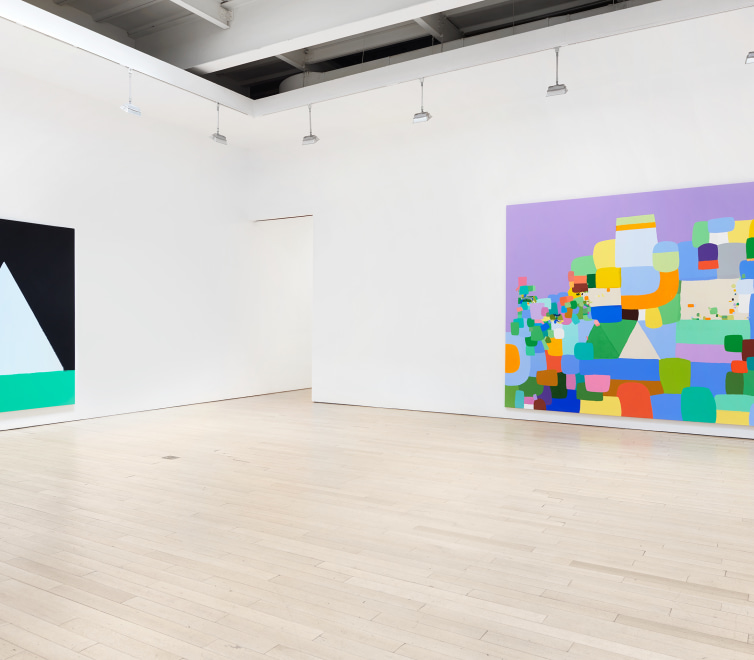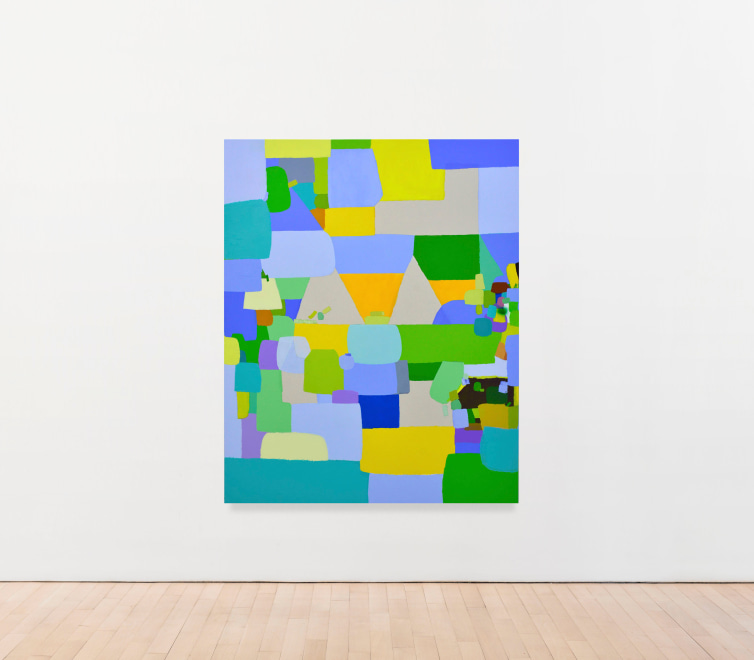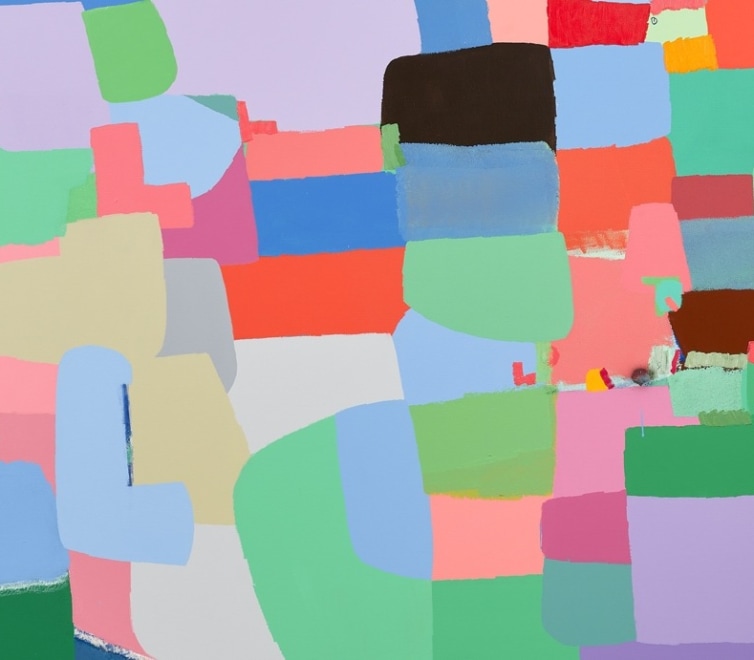
FEDERICO HERRERO
Tapezco, 2023
Oil and acrylic on canvas
51 1/8 x 55 1/8 in.
130 x 140 cm
JCG15883
FEDERICO HERRERO
Libelula, 2022
Oil and acrylic on canvas
22 1/2 x 17 3/4 in.
57 x 45 cm
JCG14730
FEDERICO HERRERO
Time, 2023
Oil and acrylic on canvas
106 1/4 x 94 1/2 in
270 x 240 cm
JCG15220
FEDERICO HERRERO
Montaña de agua (water mountain), 2023
Oil and acrylic on canvas
78 x 71 5/8 in
198.1 x 181.9 cm
JCG15223
FEDERICO HERRERO
Day, 2022
Oil and acrylic on canvas
26 3/8 x 23 5/8 in
67 x 60 cm
JCG14737
FEDERICO HERRERO
Twin Hearts, 2023
Oil and acrylic on canvas
94 1/2 x 110 1/4 in.
240 x 280 cm
JCG15221
FEDERICO HERRERO
Huracan, 2023
Oil and acrylic on canvas
78 3/4 x 63 in.
200 x 160 cm
JCG15225
FEDERICO HERRERO
Untitled, 2023
Oil and acrylic on canvas
78 x 71 5/8 in
198.1 x 181.9 cm
JCG15224
FEDERICO HERRERO
Encounter, 2023
Oil and acrylic on canvas
78 x 71 5/8 in
198.1 x 181.9 cm
JCG15217
FEDERICO HERRERO
Lost at Sea, 2023
Oil and acrylic on canvas
78 3/4 x 165 3/8 in
200 x 420 cm
JCG15219
FEDERICO HERRERO
Alphabet, 2023
Oil and acrylic on canvas
78 3/4 x 78 3/4 in.
200 x 200 cm
JCG15218
FEDERICO HERRERO
Catarata, 2022
Oil and acrylic on canvas
94 1/2 x 86 5/8 in.
240 x 220 cm
JCG14709
FEDERICO HERRERO
Flava, 2018
Oil and acrylic on canvas
94 3/8 x 86 3/4 in.
239.7 x 220.3 cm
JCG10075
FEDERICO HERRERO
The Sea, 2021
Oil and acrylic on canvas
65 x 59 1/8 in.
165 x 150 cm
JCG13096
FEDERICO HERRERO
Untitled, 2021
Oil and acrylic on canvas
65 x 59 1/8 in.
165 x 150 cm
JCG13095
Installation view, Federico Herrero, Volumes, 2022, in Concretos, curated by Gilberto González y Pablo León de la Barra, TEA Tenerife Espacio de las Artes, Tenerife, Spain, October 7, 2022 - January 8, 2023.
Installation view, Federico Herrero, Waves, 2021, wall painting and concrete volume, site-specific commission for the 2021 Thailand Biennale, Korat: Butterflies Frolicking on the Mud: Engendering Sensible Capital. Installed at the Phimai National Museum, Phimai, Thailand, December 18, 2021 - March 31, 2022.
Installation view, Federico Herrero, Waves, 2021, wall painting and concrete volume, site-specific commission for the 2021 Thailand Biennale, Korat: Butterflies Frolicking on the Mud: Engendering Sensible Capital. Installed at the Phimai National Museum, Phimai, Thailand, December 18, 2021 - March 31, 2022.
Installation view, Federico Herrero, Waves, 2021, wall painting and concrete volume, site-specific commission for the 2021 Thailand Biennale, Korat: Butterflies Frolicking on the Mud: Engendering Sensible Capital. Installed at the Phimai National Museum, Phimai, Thailand, December 18, 2021 - March 31, 2022.
FEDERICO HERRERO
Untitled, 2022
Acrylic and acuarela on paper
17 7/8 x 24 in.
45.4 x 61 cm
JCG13613
FEDERICO HERRERO
Untitled, 2022
Acrylic and acuarela on paper
24 x 17 7/8 in.
61 x 45.5 cm
JCG13611
FEDERICO HERRERO
Untitled, 2021
Acrylic on board on paper
Framed: 24 1/4 x 20 1/4 in.
(61.6 x 51.4 cm)
JCG13072
FEDERICO HERRERO
Untitled, 2021
Acrylic on board on paper
Framed: 24 1/4 x 20 1/4 in.
(61.6 x 51.4 cm)
JCG13073
FEDERICO HERRERO
Untitled, 2021
Acrylic on board on paper
Framed: 24 1/4 x 20 1/4 in.
(61.6 x 51.4 cm)
JCG13133
FEDERICO HERRERO
Untitled, 2018
Oil and acrylic on canvas
114 1/8 x 106 1/4 in.
290.0 x 270.0 cm
JCG10081
FEDERICO HERRERO
Untitled, 2018
Oil and acrylic on canvas
114 1/8 x 106 1/4 in.
290.0 x 270.0 cm
JCG10081
Installation View, Federico Herrero: Barreras Blandas, Museo Nacional de Costa Rica, San Jose, Costa Rica, August 3 – December 31, 2020
Installation View, Federico Herrero: Barreras Blandas, Museo Nacional de Costa Rica, San Jose, Costa Rica, August 3 – December 31, 2020
Installation view, Federico Herrero, Volume, James Cohan, 291 Grand St, January 17 - February 23, 2020
Installation view, Federico Herrero, Volume, James Cohan, 291 Grand St, January 17 - February 23, 2020
Installation view, Federico Herrero, Volume, James Cohan, 291 Grand St, January 17 - February 23, 2020
FEDERICO HERRERO
Monstera, 2019
Oil and acrylic on canvas
78 3/4 x 63 in.
200 x 160 cm
JCG11266
FEDERICO HERRERO
Laguna mental, 2019
Oil and acrylic on canvas
86 5/8 x 78 3/4 in.
220 x 200 cm
JCG11267
FEDERICO HERRERO
Sin título, 2019
Oil and acrylic on canvas
15 3/4 x 25 1/4 in.
40 x 64 cm
JCG11264
FEDERICO HERRERO
Moon Bird, 2019
Oil and acrylic on canvas
86 5/8 x 94 1/2 x in.
220 x 240 cm
JCG11117
FEDERICO HERRERO
Cangri, 2019
Oil and acrylic on canvas
94 1/2 x 106 1/4 in.
240 x 270 cm
JCG10408
FEDERICO HERRERO
Caravan, 2018
Oil and acrylic on canvas
118 x 157 3/8 in.
300 x 400 cm
JCG10080
Installation view, Federico Herrero, Alphabet, site-specific installation for the atrium of the Museum of Contemporary Art Chicago, Chicago, IL, August 11, 2018 - April 21, 2019
Installation view, Federico Herrero, Alphabet, site-specific installation for the atrium of the Museum of Contemporary Art Chicago, Chicago, IL, August 11, 2018 - April 21, 2019
Installation view, Federico Herrero, Alphabet, site-specific installation for the atrium of the Museum of Contemporary Art Chicago, Chicago, IL, August 11, 2018 - April 21, 2019
Installation view, Federico Herrero, Under the Same Sun: Art From Latin America Today, South London Gallery, London, UK, 2016
Installation view, Federico Herrero, Under the Same Sun: Art From Latin America Today, South London Gallery, London, UK, 2016
Installation view, 21st Century Museum of Contemporary Art, Kanazawa, Japan, March 17 - May 3, 2011
Installation view, El Bowl, San Juan, Puerto Rico, 2014
Installation view, El Bowl, San Juan, Puerto Rico, 2014
Installation view, Catarata, Museu de Arte Moderna de São Paulo, São Paulo, Brazil, October 5 - December 15, 2013
Installation view, Catarata, Museu de Arte Moderna de São Paulo, São Paulo, Brazil, October 5 - December 15, 2013
Installation view: Landscape with Circles, Art Basel Unlimited, Basel, Switzerland, 2015
FEDERICO HERRERO
Untitled, 2009
Oil on canvas
118 1/8 x 169 1/4 in.
300 x 420 cm
Installation view, Hara Museum, Tokyo, Japan, 2008
Installation view, Medellin International Art Encounter, Biennial de Medellin, Colombia, 2007
FEDERICO HERRERO
Forest, 2005
Oil on canvas
25 1/2 x 39 3/8 in.
70 x 100 cm
James Cohan Feature. Film by Greg Poole. Produced by James Cohan, 2020.
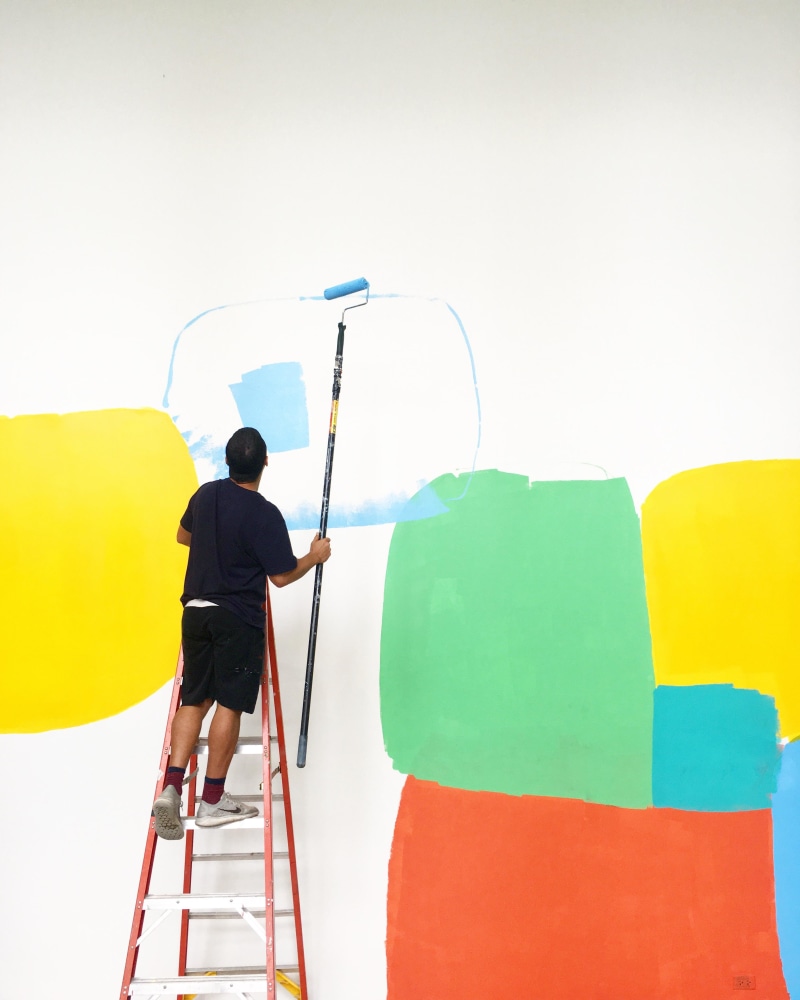
Federico Herrero’s intensely visual language is rooted in his observations of everyday life in Costa Rica’s ever evolving landscape, especially the way nature and culture collide. In his paintings on canvas, immersive installations, and public works, brightly hued organic shapes jostle against each other as they inhabit and negotiate space. There are dissonances and harmonies, which threaten to momentarily unravel but are bound together with an energy that seems to operate on a nearly atomic scale. They creep along the edges, and often break free of the frame entirely, winding onto the walls and into the crevices of his installations' spaces.
Color for Herrero is an expression of space, both the absence of space and the abundance of space and the relationship between them. His canvases and installations therefore become exercises in seeing that compel the viewer to experience their environment in novel ways. Of his varied practice Herrero states, “When painting on a canvas, you know there is no transgression; it acquires a rhythm of production that is related to yourself...One deals with a personal universe, the other deals with a social vocation.” Through this duality, Herrero’s practice is essentially a study of liminal spaces—gaps between public and private, canvas and wall, figure and background, work and viewer--always infused with elements of play, pleasure, and humor.
Federico Herrero (b. 1978, San Jose, Costa Rica) has exhibited widely internationally, with solo exhibitions and public installations in São Paulo, Brazil; San Francisco, CA; Dusseldorf, Germany; Kanazawa, Japan; Tokyo, Japan; Mexico City, Mexico; Freiburg, Germany; and London, UK. Recent major institutional projects include Tactiles, Kunsthalle Lissabon, Lisbon, Portugal (2022); Barreras Blandas, Museo Nacional de Costa Rica, San Jose, Costa Rica (2020); Tempo aberto, Museu de Arte Contemporânea de Niterói, São Paulo (2019); Open Envelope, Witte de With, Rotterdam, the Netherlands (2018); and Alphabet, a site-specific installation for the atrium of the Museum of Contemporary Art Chicago (2018). Herrero's work was featured in the 2021 Thailand Biennale. He was the recipient of the Young Artist’s Prize at the 49th Venice Biennale (2001) and his work is in the permanent collection of numerous institutions including the 21st Century Museum of Contemporary Art in Kanazawa, Japan; CCA Wattis Institute for Contemporary Arts, San Francisco, CA; Denver Art Museum, Denver, CO; Ella Fontanels-Cisneros Collection, Miami, FL; Hara Museum of Contemporary Art, Tokyo, Japan; ME Collectors Room, Berlin, Germany; MUAC, Mexico City, Mexico; MUDAM, Luxembourg City, Luxembourg; MUSAC, Castilla y León, Spain; Museo de Santander, Spain; Museo Nacional Centro de Arte Reina Sofía, Madrid, Spain; Museu de Arte de São Paulo, Brazil; Palm Springs Museum of Art, Palm Springs, CA; PAMM, Miami, FL; Saatchi Gallery, London, UK; Solomon R. Guggenheim Museum, New York, NY; Tate Modern, London, UK; and Towada Art Center, Aomori Prefecture, Japan. Herrero is also the founder of Despacio and Cero Uno, two contemporary art spaces in his native San Jose, which have served as important forces in the continued development of Central America’s artistic voice. He lives and works in San Jose, Costa Rica.
Federico Herrero’s intensely visual language is rooted in his observations of everyday life in Costa Rica’s ever evolving landscape, especially the way nature and culture collide. In his paintings on canvas, immersive installations, and public works, brightly hued organic shapes jostle against each other as they inhabit and negotiate space. There are dissonances and harmonies, which threaten to momentarily unravel but are bound together with an energy that seems to operate on a nearly atomic scale. They creep along the edges, and often break free of the frame entirely, winding onto the walls and into the crevices of his installations' spaces.
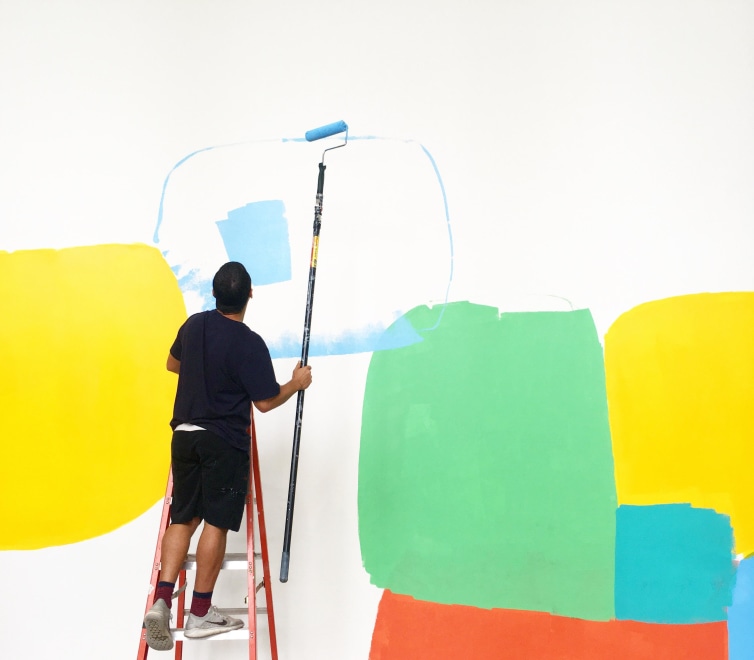
Federico Herrero sees paintings everywhere, from street curbs and traffic signs to the painted trees and stones which proliferate in his native San José, Costa Rica. In this video, Herrero discusses his use of photography and 'found paintings' from his San José home-studio, highlighting the tangible connection between the artist's environment and practice.
